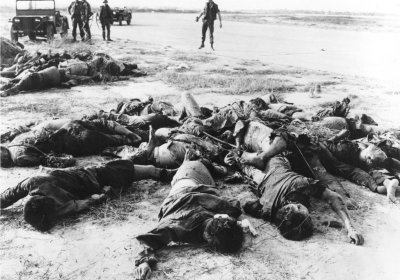The reality of the Vietnam War as a brutal, imperialist adventure has been carefully omitted from official ceremonies in the United States held to mark the 50th anniversary of the war’s beginning in 1962.
Starting this year, the government will implement “a 13-year program to honor and give thanks to a generation of proud Americans who saw our country through one of the most challenging missions we have ever faced”.
Vietnam
Arriving in a village in southern Vietnam, I caught sight of two children who bore witness to the longest war of the 20th century.
Their terrible deformities were familiar. All along the Mekong river, where the forests were petrified and silent, small human mutations lived as best they could.
Today, at the Tu Du paediatrics hospital in Saigon, a former operating theatre is known as the "collection room" and, unofficially, as the "room of horrors". It has shelves of large bottles containing grotesque foetuses.
In the Crossfire: Adventures of a Vietnamese Revolutionary
By Ngo Van
AK Press, 2011
264 pages, $43.99
Australians know of the Vietnam War from the arrival of Australian troops in 1965 through to their withdrawal in 1973. People in the United States generally date it from the arrival of US advisors through to the inglorious departure of US helicopters in 1975.
However, for the Vietnamese the struggle began long before that, from their colonisation by the French in the 19th Century.
Even though the US war on Vietnam ended nearly 40 years ago, the US’s saturation chemical bombing during that war is still wreaking havoc on the lives of at least 3 million people in Vietnam — including the newly born, making them third generation victims.
Nobody knows when the congenital deformities, one of many horrific health consequences of the toxic chemicals, will end.
How do wars begin? With a “master illusion”, according to Ralph McGehee, one of the CIA’s pioneers in “black propaganda”, known today as “news management”.
In 1983, he described to me how the CIA had faked an “incident” that became the “conclusive proof of North Vietnam’s aggression”.
This followed a claim, also fake, that North Vietnamese torpedo boats had attacked a US warship in the Gulf of Tonkin in August 1964.
On June 25, federal trade minister Simon Crean signed a deal to export up to 20 million tonnes of dried brown coal to Vietnam. The deal was signed with ironically-named Victorian company Environmental Clean Technologies (ECT). Fifty people protested outside the venue in Southbank where the deal was signed, despite the rain and only a few hours notice of the event.
Last Night I Dreamed of Peace: An Extraordinary Diary of Courage from the Vietnam War
By Dand Thuy Tram
Rider, 2007
225 pages, $32.95 (pb)
By Dand Thuy Tram
Rider, 2007
225 pages, $32.95 (pb)
Forty years ago, the Tet Offensive changed the course of the Vietnam War and world history. On January 31, 1968, fighters of the North Vietnamese Army (NVA) and the National Liberation Front of South Vietnam (NLF) — known dismissively as the “Vietcong” — launched an all-out assault on cities and towns throughout US-occupied South Vietnam, catching the US and its puppet regime completely by surprise, and stunning the world with their courage and audacity.
Whenever a socialist from the generation whose political ideas were shaped by involvement in the global movement against the US-led Vietnam War pay their first visit to Vietnam, it is a bit like a pilgrimage. It is an encounter with a symbolic home of our political hopes and convictions.
On April 29, eight solidarity groups from across Europe adopted a Public Appeal of International Lawyers issued in December that calls on the US government to honour its responsibility towards the Vietnamese victims of Agent Orange. Used during the Vietnam War, this dioxin-rich defoliant is still seriously contaminating pockets of Vietnams environment and food chain, with devastating human consequences.
Nearly 700,000 people have signed an international online petition in solidarity with Vietnams victims of Agent Orange, which was sprayed extensively by the US military during the Vietnam War. The petition, which was launched in 2004, will be presented to the judges of the US Court of Appeal on the eve of an expected June ruling on a victims lawsuit against the nearly 40 chemical companies that produced the deadly chemical for the US military.
Through its Vietnam ambassador, the Bush administration announced on February 9 that it will fund 40% of a US$1 million plan to study how to clean up a former US military base in Vietnam that is contaminated by dioxin, a class-one human carcinogen. Dioxin was a key ingredient in Agent Orange, a defoliant that Washington used extensively in the Vietnam War from 1961 to 1971.
- Previous page
- Page 2





